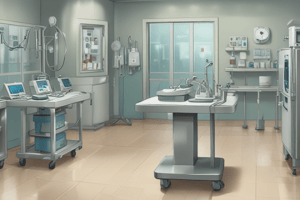Podcast
Questions and Answers
What is the primary function of a Central Sterile Supply Department?
What is the primary function of a Central Sterile Supply Department?
- Sterilization and distribution of medical instruments (correct)
- Scheduling surgeries
- Medication administration
- Patient intake management
Which of the following is NOT a sterilization method used by the CSSD?
Which of the following is NOT a sterilization method used by the CSSD?
- Boiling water (correct)
- Dry heat sterilization
- Hydrogen peroxide plasma
- Autoclaving
What process involves cleaning instruments to remove contaminants in the CSSD?
What process involves cleaning instruments to remove contaminants in the CSSD?
- Packaging
- Distribution
- Inventory management
- Decontamination (correct)
How does the CSSD contribute to patient safety?
How does the CSSD contribute to patient safety?
Which area must the CSSD organize to maintain sterility until use?
Which area must the CSSD organize to maintain sterility until use?
Which of the following is a major challenge faced by the CSSD?
Which of the following is a major challenge faced by the CSSD?
What type of professionals typically staff the CSSD?
What type of professionals typically staff the CSSD?
Which of the following sterilization methods uses steam under pressure?
Which of the following sterilization methods uses steam under pressure?
Why is proper packaging essential in the CSSD?
Why is proper packaging essential in the CSSD?
What must the CSSD comply with to ensure safe sterilization processes?
What must the CSSD comply with to ensure safe sterilization processes?
Flashcards are hidden until you start studying
Study Notes
CSSD (Central Sterile Supply Department)
-
Definition:
- A department in healthcare facilities responsible for the sterilization and distribution of medical instruments and supplies.
-
Functions:
- Sterilization: Ensures that all surgical instruments and medical devices are free from microorganisms.
- Inventory Management: Tracks and manages the supply of sterile items.
- Packaging: Properly packages instruments for storage and transportation.
- Quality Control: Implements and follows protocols to maintain the sterility and functionality of supplies.
-
Key Processes:
- Decontamination: Cleaning of instruments to remove blood, tissue, and other contaminants.
- Sterilization Methods:
- Autoclaving (steam under pressure)
- Ethylene Oxide gas
- Hydrogen peroxide plasma
- Dry heat sterilization
- Storage: Organized storage of sterile supplies to maintain sterility until use.
- Distribution: Efficient distribution of sterile items to various departments in the healthcare facility.
-
Importance:
- Ensures patient safety by preventing infections.
- Supports operating rooms and other medical areas with necessary sterile supplies.
- Complies with healthcare regulations and standards.
-
Staffing:
- Typically staffed by trained professionals specialized in sterile processing and infection control.
-
Challenges:
- Maintaining high standards of hygiene.
- Managing supply chain issues, especially during high demand.
- Keeping pace with technological advancements in medical devices.
-
Regulations:
- Must adhere to guidelines set by health authorities and organizations to ensure safe practices in sterilization processes.
Definition
- Central Sterile Supply Department (CSSD) manages sterilization and distribution of medical instruments and supplies in healthcare settings.
Functions
- Sterilization: Eliminates microorganisms from surgical instruments and medical devices.
- Inventory Management: Monitors and oversees the supply of sterile items.
- Packaging: Ensures proper packaging of instruments for safe storage and transportation.
- Quality Control: Follows strict protocols to maintain both sterility and functionality of supplies.
Key Processes
- Decontamination: Initial cleaning of instruments to eliminate blood, tissue, and contaminants.
- Sterilization Methods:
- Autoclaving uses steam under pressure for effective disinfection.
- Ethylene Oxide gas offers an alternative method for sterilizing heat-sensitive items.
- Hydrogen peroxide plasma sterilization is rapid and eco-friendly.
- Dry heat sterilization is suitable for items that may be damaged by moisture.
- Storage: Ensures organized handling of sterile supplies to preserve their sterility until needed.
- Distribution: Facilitates timely delivery of sterile items to various medical departments.
Importance
- Critical for patient safety by reducing risk of infections.
- Vital support for operating rooms and other medical areas requiring sterile supplies.
- Operates in compliance with healthcare regulations and standards.
Staffing
- Staffed by trained professionals with expertise in sterile processing and infection control.
Challenges
- Upholding high standards of hygiene amid operational pressures.
- Navigating supply chain disruptions, particularly during high demand periods.
- Adapting to rapid technological advancements in medical devices.
Regulations
- Must comply with guidelines established by health authorities and organizations ensuring safe sterilization practices.
Studying That Suits You
Use AI to generate personalized quizzes and flashcards to suit your learning preferences.




